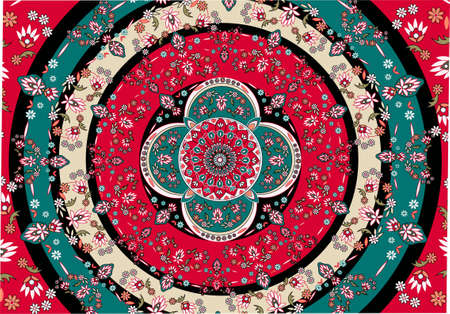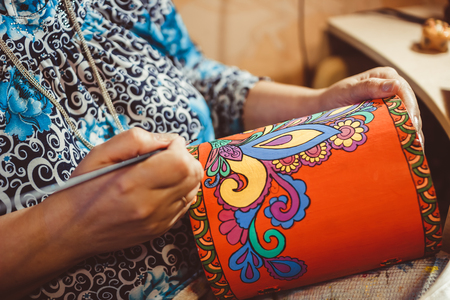Introduction to Kashmiri Embroidery
Kashmiri embroidery, renowned across India and the world, is a testament to the unmatched artistry of Kashmir’s skilled artisans. This intricate needlework, known locally as Kashida, beautifully reflects the natural splendour of the Kashmir Valley with motifs inspired by chinar leaves, flowers, birds, and paisleys. More than just decorative art, Kashmiri embroidery has deep roots in Indian culture, symbolising grace, heritage, and warmth in every thread. For generations, these embroidered textiles have held a cherished place in Indian homes—whether as elegant cushion covers, vibrant wall hangings, or statement shawls. They not only add rich texture and colour to interiors but also carry forward stories of tradition and family values. In contemporary Indian home decor, Kashmiri embroidery continues to be celebrated for its ability to blend timeless beauty with cultural pride, making every space feel welcoming and uniquely Indian.
2. Traditional Techniques and Motifs
Kashmiri embroidery is renowned across India for its intricate artistry, vibrant colours, and deep-rooted traditions that reflect the region’s rich cultural heritage. The most celebrated techniques—Sozni, Aari, and Tilla—each bring their own unique touch to home décor textiles, making them a beloved choice for Indian families looking to infuse elegance and warmth into their living spaces.
Classic Kashmiri Embroidery Styles
| Embroidery Style | Description | Common Uses in Decor |
|---|---|---|
| Sozni | Fine needlework with delicate patterns, often using silk or wool threads. Known for its detailed craftsmanship. | Shawls, cushion covers, wall hangings |
| Aari | Chain stitch embroidery done with a hooked needle, creating bold and flowing designs. Often features vibrant colours. | Bedspreads, table runners, curtains |
| Tilla | Metallic thread embroidery, traditionally in gold or silver. Adds a touch of luxury and shine. | Cushions, throws, festive decor items |
Popular Motifs in Kashmiri Textiles
Kashmiri textiles are easily recognisable by their signature motifs, which carry special meaning and are deeply connected to local culture. Among the most cherished are:
- Chinar Leaves: Symbolising strength and endurance, these motifs celebrate the majestic chinar trees of Kashmir that turn fiery red in autumn.
- Paisleys (Ambi): Inspired by the almond or mango shape, paisleys represent fertility and abundance—widely used in both traditional attire and home decor.
- Florals: Intricate floral designs capture the breathtaking beauty of Kashmiri gardens. These bring a fresh, natural vibe to any space.
Cultural Significance in Indian Homes
The timeless appeal of these techniques and motifs ensures that Kashmiri embroidered textiles remain at the heart of Indian home decor. Whether it is a Sozni-embroidered tablecloth for Diwali celebrations or Aari work cushions brightening up a drawing room, these pieces not only showcase skilled craftsmanship but also weave stories of tradition and pride into everyday life.

3. Popular Kashmiri Decor Textiles
Kashmiri embroidery, with its intricate patterns and rich cultural symbolism, is a beloved choice for home decor across India. The unique artistry of Kashmiri artisans can be seen in an array of textile products that bring warmth and elegance to Indian homes. Let’s take a closer look at some of the most popular Kashmiri decor textiles that are enhancing living spaces from Srinagar to Bengaluru.
Cushion Covers: Bringing Comfort and Colour
One cannot talk about Kashmiri embroidery without mentioning the beautiful cushion covers that adorn sofas and diwan sets in Indian households. These covers often feature traditional designs like paisleys, chinar leaves, and floral motifs, stitched using vibrant silk or wool threads. The colours and textures add a touch of sophistication to living rooms, making them inviting for family gatherings and chai sessions.
Wall Hangings: A Touch of Heritage on Your Walls
Kashmiri embroidered wall hangings are more than just decorative pieces—they are expressions of culture and history. Whether it is a grand tapestry or a smaller framed piece, these wall hangings become conversation starters during festivals or get-togethers. Many families in India display them in drawing rooms or entrance foyers as a sign of hospitality and pride in Indian heritage.
Bedspreads: Weaving Comfort with Artistry
Traditional Kashmiri bedspreads, known for their fine needlework and luxurious feel, transform bedrooms into serene retreats. These bedspreads often showcase the famous ‘Aari’ or ‘Sozni’ embroidery styles. They not only provide comfort but also reflect the aesthetic values cherished in Indian homes—where beauty meets practicality. Such pieces are especially popular as gifts during weddings or housewarming ceremonies.
Table Runners: Festive Elegance for Every Meal
No Indian festival or special occasion is complete without a beautifully set dining table, and Kashmiri embroidered table runners play a key role here. Whether it’s for Diwali feasts or Sunday brunches, these runners infuse the dining space with traditional charm. Their detailed designs often feature motifs inspired by nature, adding freshness and elegance to every meal shared with loved ones.
The Enduring Appeal of Kashmiri Decor Textiles
From functional items like cushion covers to artistic wall hangings, Kashmiri embroidered textiles have found their place in modern Indian home decor. Their timeless beauty and exquisite craftsmanship continue to win hearts across generations, reminding us of the importance of preserving India’s rich artisan legacy while celebrating everyday life at home.
4. Infusing Kashmiri Embroidery in Indian Homes
Kashmiri embroidery, with its intricate needlework and vibrant color palettes, can seamlessly enhance the beauty of Indian homes across regions. To help you infuse this traditional craft into your living spaces while honoring both regional aesthetics and practical needs, here are some tried-and-tested ideas and tips:
Blending Kashmiri Embroidery with Common Indian Decor Styles
| Home Style | Recommended Kashmiri Textile | Integration Tips |
|---|---|---|
| Traditional South Indian | Cream Pashmina throws, Sozni-embroidered cushion covers | Pair with teak or rosewood furniture, use pastel shades for a soothing contrast. |
| Contemporary Urban Apartment | Aari work wall hangings, silk runners | Add embroidered accents to neutral sofas; use as statement pieces on feature walls. |
| Rajasthani Boho-Chic | Kani shawl table runners, crewel rugs | Layer with block-printed fabrics and brass decor for a colorful fusion look. |
| Bengali Artistic Home | Kashida embroidery lampshades, Tilla-work bedspreads | Mix with local Kantha quilts for an artisanal, lived-in charm. |
| Punjabi Vibrant Setting | Zari-bordered curtains, chain stitch poufs | Complement with Phulkari textiles and bold upholstery colors. |
Practical Tips for Everyday Use
- Cushions & Throws: Place Sozni or Aari embroidered cushions on diwan sets or lounge chairs to instantly add elegance and comfort.
- Drapes & Curtains: Use Kashmiri crewel work drapes in living rooms and bedrooms for a regal yet cozy feel. Lighter shades suit smaller rooms, while rich hues add drama to larger spaces.
- Table Settings: Incorporate Kani woven runners or placemats on dining tables for festive occasions or everyday luxury.
- Wall Art: Frame detailed shawls or tapestries as wall art—especially effective in entryways or puja rooms to showcase cultural heritage.
- Bedding Accents: Layer Tilla-embroidered bedspreads over solid-color bedsheets to create a harmonious blend of texture and tradition.
- Mats & Rugs: Use chain stitch rugs in high-traffic areas like the living room; their durability matches their artistic appeal.
Cultural Sensitivity & Regional Harmony
Kashmiri textiles harmonize beautifully with various regional crafts from all corners of India. Pairing them thoughtfully—such as combining Kashmiri embroidery with Madhubani wall paintings in Bihar homes, or alongside Kerala’s mural art—creates a unique pan-Indian aesthetic that celebrates diversity without overwhelming local traditions. Remember to balance intricate patterns with plain backgrounds and let each artisan craft shine in its own space for a warm, inviting home atmosphere that reflects the best of India’s textile heritage.
5. Caring for Your Kashmiri Decor
Kashmiri embroidery and decor textiles are renowned for their delicate craftsmanship and vibrant artistry, making them treasured additions to Indian homes. To preserve their beauty and ensure they remain a part of your family’s legacy, proper care is essential.
Cleaning Tips for Kashmiri Embroidery
The intricate threads and fine fabrics used in Kashmiri textiles require gentle handling. Always avoid harsh detergents or machine washing, as this can damage the exquisite needlework. Instead, opt for mild soap and cold water when spot-cleaning. For thorough cleaning, consider professional dry-cleaning services familiar with Indian embroidered textiles.
Storing Your Decor Textiles Safely
When not in use, store your Kashmiri decor items in a cool, dry place away from direct sunlight to prevent fading of colours and weakening of threads. It is wise to wrap these pieces in soft muslin cloth or cotton sheets, allowing the fabric to breathe while protecting it from dust and insects—a practice followed in many Indian households for generations.
Maintaining Long-Lasting Beauty
Regularly inspect your Kashmiri pieces for signs of wear or loose threads. Gently trim any frayed ends with scissors rather than pulling them, which can unravel the embroidery. If you notice stains or damage, consult an expert who specialises in restoring traditional Indian textiles. With mindful care, these heirloom-worthy creations will continue to grace your home with their timeless elegance and cultural richness for years to come.
6. Supporting Artisans and Sustainable Choices
Choosing authentic Kashmiri embroidery and decor textiles is not just about bringing timeless beauty into your home—it is also about supporting the skilled artisans behind each masterpiece. When you select handcrafted items made in Kashmir, you are making a conscious decision to sustain traditional crafts that have been passed down through generations. These intricate creations represent more than just decor; they reflect the hopes, dreams, and livelihoods of entire communities.
The Power of Handcrafted Textiles
Handmade Kashmiri textiles are woven with stories, passion, and cultural pride. Every thread showcases the artisan’s patience and dedication, making each piece unique. Unlike mass-produced alternatives, these textiles carry the warmth of personal touch and the authenticity that machine-made products cannot replicate. By choosing such pieces for your home, you celebrate Indian heritage while adding a soulful charm to your living spaces.
Sustaining Local Communities
Your mindful choice directly impacts the lives of Kashmiri artisans and their families. Many artisans depend on this craft as their primary source of income. When you opt for genuine, hand-embroidered products, you help create sustainable livelihoods, uplift local economies, and keep age-old techniques alive. This support goes beyond fair trade; it builds hope and resilience in times of uncertainty, especially in regions affected by social or economic challenges.
Making Responsible and Meaningful Choices
Incorporating Kashmiri decor textiles into your home is a step towards sustainable living. Choose vendors who practice ethical sourcing and offer transparency about their products origins. Look for certifications or recommendations from organizations dedicated to artisan welfare. Remember, every purchase is an opportunity to make a positive difference—celebrate Indias rich artistry while supporting those who keep these traditions thriving.

